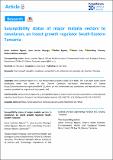| dc.description.abstract | Introduction: application of Insect Growth Regulator (IGR) such as pyriproxyfen has shown a promising result in controlling malaria transmitting mosquitoes through autodissemination technique. Novaluron that inhibits the chitin development at mosquito larval stage present a promising candidate IGR for rotation with pyriproxyfen to prevent a chance of resistance development. This study assessed the susceptibility of immature stages of Anopheles arabiensis, Anopheles gambiae and Anopheles funestus to novaluron.
Methods: susceptibility bioassays using technical grade novaluron (98% active ingredient) were performed inside the semi-field system using first instar larvae of Anopheles species. For each tested species, a total of 1500 larvae were used in the bioassay. Concentration range of 0.01 mg/l to 2 mg/l of novaluron were tested to establish Lethal Concentration (LC) sufficient to kills 50%, 90% and 99% of the exposed larvae by using log-dose response analysis.
Results: of the tested mosquitoes, Anopheles gambiae were highly susceptible to novaluron followed by An. arabiensis and then An. funestus. Lethal concentrations, LC50, LC90 and LC99 (95%CI) in mg/l for An. gambiae were 0.018, 0.332 and 2.001 respectively. For An. arabiensis were 0.026, 0.546 and 2.013; and for An. funestus were 0.032, 1.00 and 5.580. High larval mortality was recorded at high concentration (2mg/L), with 80% mortality within 3 days post exposure.
Conclusion: the study demonstrates the efficacy of novaluron in controlling Anopheles mosquito species at immature stages via larval mortality. These findings warrant further testing of novaluron for autodissemination by different vector species for its inclusion in rotation to prevent development of resistance. | en_US |

